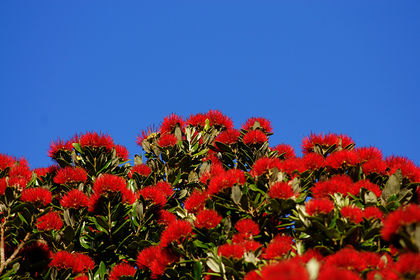Posts by Fooman
Last ←Newer Page 1 2 3 4 5 Older→ First
-
Southerly: Coming Up For Air, in reply to
I’m a huge fan of coppicing, but only really familiar with how it’s done in the UK. Other than planning a row of Sweet Chestnut, I am rather vague as to suitable species in NZ (although I have noted that eucalypts are popular for coppicing here). I’d heard of the Brandenburg Coppice, but my quick search doesn’t really come up with anything useful (I have been planning a proper trawl of academic journals).
Willow is the classic coppicing (sic?) tree – is actually the second most invasive extoic species after Pinus Radiata. A very brief google gives the following (salix = willow, the rest are obvious):
Short rotation coppice tree species selection for woody biomass production in New Zealand
Ralph E.H Sims, Tavale G Maiava, Bruce T Bullock
“Nine species of Eucalyptus were compared with one selected species of each of Salix, Acacia and Populus for woody biomass production when grown in a temperate climate under a short rotation regime. Ten clones of the promising species E. viminalis were also included in the small plot, randomised block experiment. The trees, planted at a stocking density of 5000 stems/Ha, were harvested as single stems at 3 yr of age, then again as coppice regrowth following a further 3-yr rotation. Tree survival, stump diameters (mm), heights (m), and tree dry weights were measured and used to determine the above ground biomass yields. The four replicated plots, each with five trees, of E. viminalis 3680, E. botryoides, E. pseudoglobulus and S. matsudana x alba (Moutere) showed no tree mortality even after the second harvest. Most of the other species had over 80% survival rates, E. nitens being the exception at below 50%. Average heights and dry weights of the harvested coppice trees were significantly greater than when first harvested as single stems. Mean annual incremental biomass dry matter yields (tdm/ha/yr) at the single stem harvest ranged from 2.00 tdm/ha/yr for E. nitens up to 39.72 tdm/ha/yr for E. viminalis 3683. At the coppice harvest E. nitens was again the lowest yielding (2.94 tdm/ha/yr) with other species ranging up to 50.64 tdm/ha/yr for E. pseudoglobulus. On combining total biomass yields from both rotations, most Eucalyptus species produced significantly more biomass than the other genera, with E. viminalis 3678 and E. pseudoglobulus exceeding 35 tdm/ha/yr during the 6-yr period.”
FM
-
-
-
-
OnPoint: 3 News Exclusive Investigation…, in reply to
I remember one year, my student loan was (roughly) split into 3: one part living expenses, one part fees and one part interest. The smallest figure of the three was not less than ~5.5k
Friends don't let friends post-graduate.
FM
-
Up Front: It's Not Sex, and It's Not Education, in reply to
Much more appropriate to the thread (and slightly NSFW):
FM
-
Up Front: It's Not Sex, and It's Not Education, in reply to
See, I was looking at "the 3dB line" and thinking, man, anything under about 120dB and I'd say it wasn't working...
It all depends on how you define the frequency response.
FM
-
Up Front: It's Not Sex, and It's Not Education, in reply to
(well, there might be; with my fuzzy recollection of my time at Uni I can't decide whether it's "below the Planck length" or "at the 3dB line").
You don't sound 95% confident about that.
FM
-
Up Front: It's Not Sex, and It's Not Education, in reply to
As long as we don’t start going down the same road as clothes shops and getting ‘vintage’, or ‘pre-loved’ condoms.
"The regiment votes for repair!"
FM
-
Up Front: It's Not Sex, and It's Not Education, in reply to
There used to be an outfit in Ferry Rd that made those. Quite a market among those with allergies to latex, apparently!
In my youth, I used to help my father out with some bits and bobs construction work during the university holidays.
One of these jobs was to do some maintenance work at Carter Products NZ production facility in Paritutu, just across the road from Dow Agrichemicals (as it is now).
Carter Products parent company at the time was Carter Wallace, which counted amongst it's brands one named after those from Troy.
The product made at this facility was the "lambskin" condom. One of the items of work that we did was to reline a concrete gutter - it was my job to take out all the rotting concrete that lined this gutter, which the briney brown liquids from the barrels full of sheep guts, upon arrival from the freezing works, were sloshed down to an effluent pit. That festering pile of rubble that I hacked out seemed to attract thousands of flies to the skip I was slowly filling up - I vividly remember a black swarm float up, darken the sky, and settle back down each time I delivered a wheelbarrow of mucky delight. Five tonnes of stinking, rotten concrete, all removed by (my) hand over the course of a summers days. Lots of breaks for fresh air.
Anyway, after removal from their fetid barrels, the guts were then cleaned, treated, sliced, stretched over mandrels (yes, shaped like man "drills") and baked. We were the only ones in the place as it had been shut down to pause in production, so I wandered about at break times (to get away from the stench of the work I was doing). Thousands upon thousands of the phallic formers for the shapes lay in racks next to the ovens. I was amused by the QC testing station - dozens of the product, pegged up like washing on a line, filled to the brim with an indeterminant liquid, beakers waiting underneath to catch their load if spilt/split.
The reason for the shutdown (this was in the early 90's) was that there was a gut glut when it came to prophylactics - such material would only protect against pregnancy, as they were porous to the human immunodeficiency virus, and they had fallen out of favour. These days "lambskin" is marketed as a luxury choice - supposedly having a better feel than latex, or as an alternative to those allergic to latex, who now are also accomodated by the polyurethane variety, which do filter out the HIV('s). But both the lambskin and polyurethane (I am sure there is an awfully appropriate pun in there in Māori) variety are not as elastic as latex - meaning fit and slippage is more of an issue.
Aside from a prurient teenage interest in the manufacturing of this rather interesting product, I also got out the experience one of the hardest working experiences of my life, and a cool work story, without having to join the police. Didn't get paid for the work, but.
Cheers,
FM


